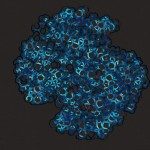Link to Pubmed [PMID] – 15180985
J. Biol. Chem. 2004 Aug;279(32):33123-30
MalK, the ATP-binding cassette component of the Escherichia coli maltodextrin transporter, has long been known to control negatively the activity of MalT, a transcriptional activator dedicated to the maltose regulon. By using a biochemical approach and the soluble form of MalK as a model substrate, we demonstrate that MalK alone inhibits transcription activation by MalT in a purified transcription system. The inhibitory effect observed in vitro is relieved by maltotriose and by two malT mutations and one malK mutation known to interfere with MalT repression by MalK in vivo. MalK interacts directly with the activator in the absence of maltotriose but not in the presence of maltotriose. Conversely, MalK inhibits maltotriose binding by MalT. Altogether, these data strongly suggest that MalK and maltotriose compete for MalT binding. Part, if not all, of the MalK-binding site is located on DT1, the N-terminal domain of MalT. All of these features indicate that MalK inhibits MalT by the same mechanism as two other proteins, MalY and Aes, that also act as negative effectors of MalT by antagonizing maltotriose binding by MalT. These results offer new insights into the mechanism by which gene regulation can be accomplished by the ATPase component of a bacterial ATP-binding cassette-type importer.

